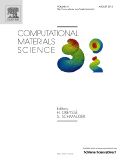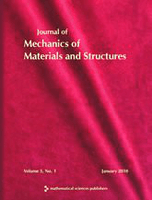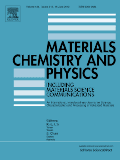
COMPUTATIONAL MATERIALS SCIENCE
Scope & Guideline
Exploring the Fusion of Computation and Materials
Introduction
Aims and Scopes
- Computational Modeling and Simulation:
The journal emphasizes the use of computational methods such as molecular dynamics, density functional theory (DFT), and phase-field modeling to investigate the structural, electronic, and mechanical properties of materials. - Machine Learning Applications:
There is a growing focus on integrating machine learning techniques with traditional computational methods to enhance the predictive capabilities for materials design and optimization. - Interfacial Phenomena and Defect Dynamics:
Research often explores how defects, interfaces, and grain boundaries influence the overall properties of materials, particularly in complex alloys and nanostructured materials. - Thermodynamics and Phase Stability:
The journal covers studies related to the thermodynamic stability of materials and phase transitions, often utilizing CALPHAD methods alongside first-principles calculations. - Nanomaterials and Thin Films:
Special attention is given to the properties of nanomaterials and thin films, including their synthesis, characterization, and potential applications in various technological fields. - Multiscale Modeling Approaches:
The integration of various modeling scales, from atomic to continuum, is a key feature, allowing for comprehensive studies of material behavior under different conditions.
Trending and Emerging
- Integration of Machine Learning in Materials Science:
There is a significant increase in research integrating machine learning techniques for predicting material properties, optimizing compositions, and accelerating the discovery of new materials. - Investigation of 2D Materials:
Research on two-dimensional materials, such as graphene and transition metal dichalcogenides, is gaining momentum, with studies focusing on their unique properties and potential applications in electronics and energy storage. - Sustainability and Green Materials:
Emerging studies emphasize the development of sustainable materials and processes, including recycling, energy-efficient synthesis, and low-impact materials for various applications. - Advanced Characterization Techniques:
The use of advanced characterization methods, such as in-situ techniques and high-resolution microscopy, is trending, allowing for better understanding of material behaviors at the nanoscale. - Quantum Computing Applications in Materials Science:
There is a growing interest in applying quantum computing approaches to solve complex materials science problems, particularly in the realm of electronic structure calculations and simulations.
Declining or Waning
- Traditional Empirical Potentials:
There has been a noticeable decline in the use of traditional empirical potential methods for simulations as researchers increasingly favor machine learning-based interatomic potentials, which offer greater accuracy and flexibility. - Static Structural Analysis:
Static approaches to structural analysis are becoming less common, with a shift towards dynamic simulations that account for time-dependent behaviors and interactions in materials. - Single-Scale Modeling:
Research focusing solely on single-scale modeling (e.g., atomistic or continuum) has decreased, as the community increasingly recognizes the need for multiscale approaches to capture complex phenomena. - Classical Molecular Dynamics without Machine Learning Enhancements:
The application of classical molecular dynamics without incorporating machine learning techniques is waning, as the benefits of data-driven approaches become more apparent in enhancing simulation accuracy and efficiency.
Similar Journals

C-Journal of Carbon Research
Leading the Charge in Carbon Innovations and Environmental SolutionsC-Journal of Carbon Research is an innovative and dynamic journal published by MDPI, situated in the picturesque city of Basel, Switzerland. Launched in 2015 and operating under an Open Access model, the journal aims to promote the dissemination of high-quality research related to carbon science, environmental sustainability, and renewable resources. With a current impact factor reflecting its growing influence in the field, the journal's standing is bolstered by its Scopus ranking, placing it in the 37th percentile in the Environmental Science category. It offers a platform for researchers, professionals, and students alike to engage with cutting-edge studies, reviews, and discussions that contribute to environmental science advancements. As the journal continues its convergence journey from 2022 to 2024, it remains committed to fostering scholarly exchange and interdisciplinary collaboration on pressing carbon-related challenges.

Letters on Materials
Illuminating the path of discovery in materials engineering.Letters on Materials, published by the Russian Academy of Sciences, Institute of Metals Superplasticity Problems, serves as a vital platform in the diverse field of materials science. Established in 2014 and running through 2024, this journal has carved a niche as a Q3 category publication, focusing on innovative research and developments in materials science and engineering. With its ISSN 2218-5046 and E-ISSN 2410-3535, it provides a unique opportunity for researchers and industry professionals to disseminate significant findings and theoretical advancements within the materials domain. While currently not categorized as open access, the journal maintains a global reach, promoting scientific dialogue and collaboration particularly within the Russian Federation and broader international audiences. Its placement within the 25th percentile in the Scopus rankings underscores its emerging significance, making it essential reading for anyone interested in cutting-edge materials research.

Journal of Mechanics of Materials and Structures
Innovating Insights in Applied Mathematics and Structural Mechanics.Journal of Mechanics of Materials and Structures, published by Mathematical Science Publishers, is a distinguished periodical in the field of Applied Mathematics and Mechanics of Materials. With the ISSN 1559-3959, this journal has been a pivotal platform since its inception in 2006, providing insights and advancements in the mechanics of materials and their structural applications. Operating out of the University of California, Berkeley, this journal not only boasts a respectable standing within its categories, ranking Q4 in Applied Mathematics and Q3 in Mechanics of Materials as of 2023, but it also serves a crucial role in fostering academic discourse among researchers, practitioners, and students alike. Although it does not currently offer open access, its contributions to the respective fields are invaluable, underscoring the relevance and importance of continued research in understanding material behavior and structural integrity. Whether investigating theoretical frameworks or engineering applications, the Journal of Mechanics of Materials and Structures remains an essential resource for anyone dedicated to the advancement of the science of materials and structures.

Computational and Theoretical Chemistry
Exploring the Nexus of Theory and ComputationComputational and Theoretical Chemistry, published by ELSEVIER, stands at the forefront of interdisciplinary research in the realms of computational chemistry, theoretical physics, and biochemistry. With its ISSN 2210-271X and E-ISSN 1872-7999, the journal has established a significant presence in the academic community since its inception. Covering innovative computational methodologies and theoretical advancements, it addresses critical issues in condensed matter physics and molecular biochemistry, providing a rich resource for scholars and industry professionals alike. The journal enjoys a respectable impact factor and ranks notably in several Scopus categories, making it a vital platform for disseminating high-quality research. It adopts an open-access model, facilitating wider readership and engagement, which is essential for fostering collaborative innovations in the scientific landscape. As it continues to evolve from 2011 to 2024, Computational and Theoretical Chemistry is committed to advancing knowledge and promoting insightful discussions within the scientific community.

MATERIALS CHEMISTRY AND PHYSICS
Shaping the Future of Materials through Rigorous ResearchMATERIALS CHEMISTRY AND PHYSICS is a leading peer-reviewed journal published by Elsevier Science SA, focusing on the intersection of materials science and condensed matter physics. With an esteemed impact factor and a distinguished reputation in its field, this journal holds a Q1 ranking in Condensed Matter Physics and a Q2 ranking in miscellaneous Materials Science categories as of 2023. Spanning over three decades since its inception in 1983, it provides a vital platform for researchers, professionals, and students to disseminate cutting-edge findings and innovations in materials characterization, properties, and applications. The journal is indexed in Scopus, boasting impressive rankings that reflect its commitment to publishing high-quality research. Although it does not currently offer an Open Access option, it remains an essential resource for those seeking to stay at the forefront of materials chemistry and physics.

JOURNAL OF PHYSICS-CONDENSED MATTER
Illuminating the Evolving Landscape of Materials Research.JOURNAL OF PHYSICS-CONDENSED MATTER, published by IOP Publishing Ltd, stands as a premier platform for the dissemination of impactful research in the fields of condensed matter physics and materials science. Since its inception in 1989, this journal has successfully bridged the gap between fundamental and applied research, delivering cutting-edge findings pertinent to both the academic community and industry professionals. Ranking in the Q2 category for both Condensed Matter Physics and Materials Science, it holds a respectable position within the scientific community, as evidenced by its Scopus rankings. With a commitment to fostering innovative research and promoting open dialogue, the journal offers a substantial collection of articles that contribute to the evolving landscape of materials science and physics. Researchers and students are encouraged to engage with the journal’s rich content, which not only enhances their academic pursuits but also plays a crucial role in advancing technologies based on solid-state materials.

Materials Physics and Mechanics
Unlocking the Secrets of Material BehaviorMaterials Physics and Mechanics is a pivotal journal dedicated to advancing the fields of condensed matter physics, materials science, mechanical engineering, and the mechanics of materials. Published by the Institute of Problems in Mechanical Engineering, Russian Academy of Sciences, this journal has established itself as a valuable resource since its inception, particularly from 2003 to 2004 and now continuously from 2009 to 2024. Although it currently holds a Q4 categorization in various disciplines, its contributions are critical to understanding and developing new materials and their applications in engineering. The journal provides insightful articles that explore the nuances of material properties, their behaviors under different conditions, and the physical principles governing these phenomena. Though it operates under a traditional publication model, the insights provided within its pages are invaluable to researchers, professionals, and students striving to push the boundaries of knowledge in the materials domain. Its ISSN numbers (1605-2730, E-ISSN 1605-8119) serve as a gateway to a wealth of scientific knowledge emanating from the Russian Federation, contributing to the global discourse in materials physics and mechanics.

PHYSICS OF THE SOLID STATE
Connecting Academia and Industry through Rigorous ResearchPhysics of the Solid State is a distinguished journal published by Pleiades Publishing Inc., focusing on the rapid advancements and fundamental research in the realms of condensed matter physics, electronic, optical, and magnetic materials. With an ISSN of 1063-7834 and an E-ISSN of 1090-6460, this journal serves as a crucial platform for disseminating high-quality research findings, insights, and reviews essential for both academic and industrial professionals in the field. As of 2023, its Scopus ranking places it in the 26th percentile for both Condensed Matter Physics and Electronic, Optical and Magnetic Materials, reflecting its evolving influence and contribution to the scientific community. Although currently classified in the Q4 quartile, the journal aims to foster interdisciplinary dialogue, improve research visibility, and enhance its impact on contemporary scientific challenges through rigorous peer-reviewed articles and focused special issues. Despite its traditional model of access, it continues to play a pivotal role in engaging researchers and fostering innovation in solid-state physics.

TRANSACTIONS OF THE INDIAN INSTITUTE OF METALS
Unveiling new horizons in metal science.TRANSACTIONS OF THE INDIAN INSTITUTE OF METALS is a premier journal published by Springer India, dedicated to the field of metallurgy and materials science. Established in 1969, this journal serves as a vital platform for researchers and professionals to disseminate their findings on metals and alloys, showcasing innovative studies and experimental techniques. With an impressive impact factor and categorized in the Q2 quartile for metals and alloys as of 2023, it ranks 70 out of 176 in its field according to Scopus, placing it in the 60th percentile. The journal maintains a robust reputation for fostering academic excellence, thus attracting contributions from both established and emerging scholars. Though not an open access publication, its well-curated content remains a crucial resource for advancing knowledge and technology in metallurgy. The journal's extensive operational history, particularly during notable converged years, underscores its enduring significance in the scientific community.

International Journal of Applied Mechanics
Advancing the Frontiers of Applied MechanicsThe International Journal of Applied Mechanics, published by World Scientific Publishing Co Pte Ltd, is a premier platform that serves the fields of materials science, mechanical engineering, and mechanics of materials. Located in Singapore, this journal has established itself as a crucial resource for researchers, professionals, and students, with its convergence of scholarly work from 2009 to 2024. Ranked in the Q2 category across notable disciplines, including Materials Science, Mechanical Engineering, and Mechanics of Materials, it reflects a strong commitment to publishing high-quality research that pushes the boundaries of knowledge in applied mechanics. Despite being a non-open access journal, its successful Scopus rankings, including an impressive rank of #151 in Mechanical Engineering, signify its substantial impact and recognition within the academic community. This journal not only aims to disseminate pioneering research but also to foster collaboration and innovation in the rapidly evolving landscape of applied mechanics.